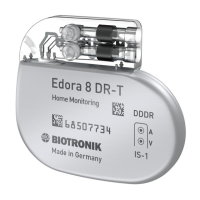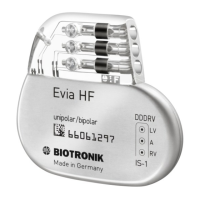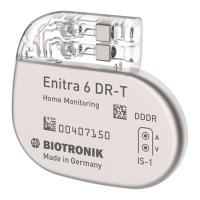Do you have a question about the BIOTRONIK Eluna 8 and is the answer not in the manual?
Defines the purpose and objectives of the Eluna pacemaker for bradycardia therapy.
Explains how the device monitors and treats cardiac rhythm using BIOTRONIK Home Monitoring.
Lists general guidelines and device type indications based on symptoms and cardiology recommendations.
Details indicated pacing modes for various cardiac symptoms and conditions.
Explains the safety of ProMRI® labeled pacemakers in MRI environments.
Mentions general guidelines and the need to check parameter compatibility after programming.
Lists specific contraindications for pacing modes and parameter combinations.
Describes the different Eluna device variants (SR, DR, HF) with/without Home Monitoring.
Details the device housing material and explains IS-1 lead connection assignments.
Describes BIOTRONIK leads and explains telemetric communication via SafeSync®.
Details the programmer's role in implantation, follow-up, and data management.
Lists pacing modes for device types and explains NBG codes for device configurations.
Describes the therapy management system and its features for remote monitoring.
Lists order numbers for Eluna devices and details package contents.
Highlights features for diagnosis, data recording, and IEGM display.
Describes automatic adjustments for pacing thresholds, timing, and rate adaptation (CLS).
Details VV delay configuration and diagnostics for triple-chamber devices for resynchronization.
Explains the two types of therapy programs: default and individual settings.
Lists information automatically sent by the device via Home Monitoring.
Lists applicable technical manuals and specifies operating conditions.
Provides guidelines for shipping, storage, temperature, and single-use sterility.
Covers general medical complications, technical failures, and specific issues like myopotentials.
Discusses device sensitivity to EMI, behavior during interference, and static magnetic fields.
Lists procedures that may harm the patient or device and risks from diagnostic/therapeutic procedures.
Explains device protection from defibrillation and risks associated with radiation therapy.
Advises against MRI due to field effects and details ProMRI® conditional use.
Lists required components for implantation and emphasizes having a defibrillator ready.
Provides instructions and warnings for safe unpacking and checking of device components.
Describes general implantation sites and provides a step-by-step overview of the process.
Details handling the header, set screws, and preventing short circuits from open connector ports.
Warns about inadequate therapy due to improper lead spacing or contact.
Details the step-by-step process for connecting leads to the device header.
Explains positioning the programming head and establishing telemetry contact.
Describes the auto-initialization process and device behavior during this phase.
Advises on checking the device system, performing tests, and monitoring the patient.
Covers telemetry interruption, cancellation, critical parameter settings, and sensitivity.
Details functions to prevent complications like PMT, atrial tachycardia, and risks from LV pacing.
Explains how to recognize lead failure and discusses power consumption and service time.
Details magnet response settings for standard programs and after reaching ERI.
Provides guidance for patients on when and how to perform magnet application.
Defines intervals for in-office follow-up and explains Home Monitoring support.
Covers patient ID card, prohibitive signs, and sources of electromagnetic interference.
Explains battery levels, ERI activation, display, and mode changes upon reaching ERI.
Lists functions deactivated with ERI and details expected service time after ERI.
Provides instructions for explantation, device replacement, cremation, and safe disposal.
Defines basic rate, night rate, rate changes, and hysteresis settings.
Details AV delay, sense compensation, safety interval, and AV hysteresis configurations.
Covers ventricular pacing modes, triggering, upper rate limits, and Wenckebach response.
Details mode switching criteria, intervention rates, and ventricular pacing suppression.
Defines refractory periods (including PVARP) and blanking periods.
Explains PMT protection, VA criterion, pulse amplitude, pulse width, and sensitivity settings.
Details settings for atrial and ventricular capture control, including safety margins.
Describes lead polarity settings, atrial overdrive pacing, and IEGM recording types.
Covers IEGM recordings, statistical rates, CLS, and accelerometer-based rate adaptation.
Details MRI program modes and preset parameters for ProMRI® devices.
Describes standard/safe programs, lead configuration, and post-initialization parameters.
Covers AV hysteresis, sense compensation, AV safety delay, and VW delay.
Includes T-wave protection, far-field protection, PMT protection, VA criterion, and sensitivity.
Details pulse amplitude, width, refractory periods, and magnet response.
Covers mode switching, onset/resolution criteria, capture control, and pacing suppression.
Lists tolerances for basic rate, interval, magnet rate, pulse amplitude, and pulse width.
Details tolerances for sensitivity, refractory periods, lead impedance, and activity rates.
Provides dimensions, volume, mass for device housings and lists contact materials.
Specifies X-ray ID, electrically conductive surface, components, and interference resistance.
Lists battery specifications and explains service time reduction after storage.
Details power consumption values and factors for calculating mean service times.
Provides estimated mean service times for SR(-T) devices based on various parameters.
Explains the meaning of various icons found on device labels, including MR conditional.
Shows examples of device types, NBG codes, connectors, and associated items.
| Device Type | Pacemaker |
|---|---|
| Model | Eluna 8 |
| Manufacturer | BIOTRONIK |
| MRI Conditional | Yes |
| Rate Response | Yes |
| Wireless Remote Monitoring | Yes |












